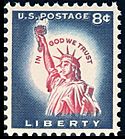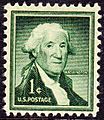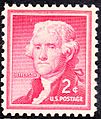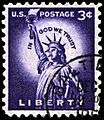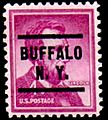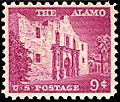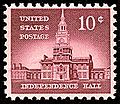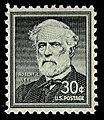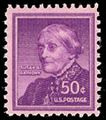Liberty Issue facts for kids
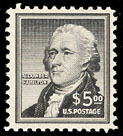
The Liberty issue was a special set of postage stamps released in the United States. These stamps came out between 1954 and 1965. There were twenty-four different stamps, from a tiny half-cent stamp showing Benjamin Franklin to a five-dollar stamp with Alexander Hamilton.
What made this series unique? For the first time since 1870, the regular 3-cent stamp for a letter didn't show a president. Instead, it featured a picture of the Statue of Liberty. The Statue of Liberty also appeared on the 8-cent and 11-cent stamps. That's why the whole series is called the Liberty issue!
You could also find pictures of other famous places on these stamps. These included Bunker Hill and Mount Vernon. Most other stamps in the series showed portraits of well-known historical Americans. Some stamps, like those for The Alamo or Monticello, showed buildings. These were designed horizontally, which was a new mix of horizontal and vertical stamps for a U.S. series.
Contents
What Made These Stamps Special?
The Liberty series was one of the few U.S. stamp sets to feature only one important woman. In earlier sets, Martha Washington was often shown. But in the Liberty Issue, Susan B. Anthony was featured on the 50-cent stamp instead.
This series was also the first in a long time not to honor a recently deceased president. For example, Franklin D. Roosevelt had passed away nine years before. He was not included in this new series. Only 28% of the Liberty series stamps showed presidents. This was a smaller percentage than in any previous U.S. stamp set.
When Were They Released?
The first Liberty stamps came out in 1954. Most of the set was ready by 1960, but a few more stamps were added later. The Liberty stamps were mostly replaced by the Prominent Americans series starting in 1965. However, some Liberty stamps were still sold for many years.
For example, two coil stamps (stamps sold in rolls) were printed again and again. These were the 2-cent Thomas Jefferson and the 25-cent Paul Revere stamps. They were still available for sale well into the 1980s. Even some 12-cent Benjamin Harrison stamps were sold in 1981. This happened because the United States Postal Service needed a 12-cent stamp quickly for a new postal card rate.
Printing Changes Over Time
Over the years that these stamps were made, the way stamps were printed changed. This means that many stamps in the Liberty series have different versions. They might have been printed on different types of paper. They might also have different perforations (the tiny holes that help you tear stamps apart). Some even had a special phosphor coating added. Because of these changes, collecting all the different types of Liberty stamps can be quite complex!
The half-cent stamp in this series was the last one of that value used for regular postage. It was also the last time Benjamin Franklin appeared on a low-value stamp in a regular series. This had been a tradition since 1847. This series also introduced two new fractional stamp values: 1¼¢ and 2½¢.
Stamps of the Liberty Issue: First Release Dates and Places
|
|
Here is a list of the stamps in the Liberty issue and where and when they were first sold:
- ½¢ Benjamin Franklin, Washington, D.C. - October 20, 1955
- 1¢ George Washington, Chicago, IL - August 26, 1954
- 1¼¢ Palace of the Governors, Santa Fe, NM - June 17, 1960
- 1½¢ Mount Vernon, Mount Vernon, VA - February 22, 1956
- 2¢ Thomas Jefferson, San Francisco, CA - September 15, 1954
- 2½¢ Bunker Hill Monument, Boston, MA - June 17, 1959
- 3¢ Statue of Liberty, Albany, NY - June 24, 1954
- 4¢ Abraham Lincoln, New York, NY - November 19, 1954
- 4½¢ The Hermitage, Hermitage, TN - March 16, 1959
- 5¢ James Monroe, Fredericksburg, VA - December 2, 1954
- 6¢ Theodore Roosevelt, New York, NY - November 18, 1955
- 7¢ Woodrow Wilson, Staunton, VA - January 10, 1956
- 8¢ Statue of Liberty (Rotary Press-Flat Plate), Washington, D.C. - April 9, 1954
- 8¢ Statue of Liberty (Giori Press), Cleveland, OH - March 22, 1958
- 8¢ John J. Pershing, New York, NY - November 17, 1961
- 9¢ Alamo, San Antonio, TX - June 14, 1956
- 10¢ Independence Hall, Philadelphia, PA - July 4, 1956
- 11¢ Statue of Liberty, Washington, D.C. - June 15, 1961
- 12¢ Benjamin Harrison, Oxford, OH - June 6, 1959
- 15¢ John Jay, Washington, D.C. - December 12, 1958
- 20¢ Monticello, Charlottesville, VA - April 13, 1956
- 25¢ Paul Revere, Boston, MA - April 18, 1958
- 30¢ Robert E. Lee, Norfolk, VA - September 21, 1955
- 40¢ John Marshall, Richmond, VA - September 24, 1955
- 50¢ Susan B. Anthony, Louisville, KY - August 25, 1955
- $1 Patrick Henry, Joplin, MO - October 7, 1955
- $5 Alexander Hamilton, Paterson, NJ - March 19, 1956
Coil Stamps
These stamps were sold in rolls:
- 1¢ George Washington, Baltimore, MD - October 8, 1954
- 1¼¢ Palace of the Governors, Santa Fe, NM - June 17, 1960
- 2¢ Thomas Jefferson, St. Louis, MO - October 22, 1954
- 2½¢ Bunker Hill, Los Angeles, CA - September 9, 1959
- 3¢ Statue of Liberty, Washington, D.C. - July 20, 1954
- 4¢ Abraham Lincoln, Mandan, ND - July 31, 1958
- 4½¢ The Hermitage, Denver, CO - May 1, 1959
- 25¢ Paul Revere, Wheaton, MD - February 25, 1965
A Rare Stamp Variety
In late 1954, the Bureau of Engraving and Printing tried a new type of paper for some stamps. They used "Silkote" paper, which was whiter and smoother. The goal was to see if this paper would help prevent stamps from shrinking after printing. About 50,000 of these special 2-cent stamps were made. They were sold in Westbrook, Maine, starting December 17, 1954.
Stamps printed on Silkote paper look much sharper and brighter. Even though the new paper worked well, it cost too much to use all the time. Today, it's thought that only about 400 of these rare stamps still exist!


